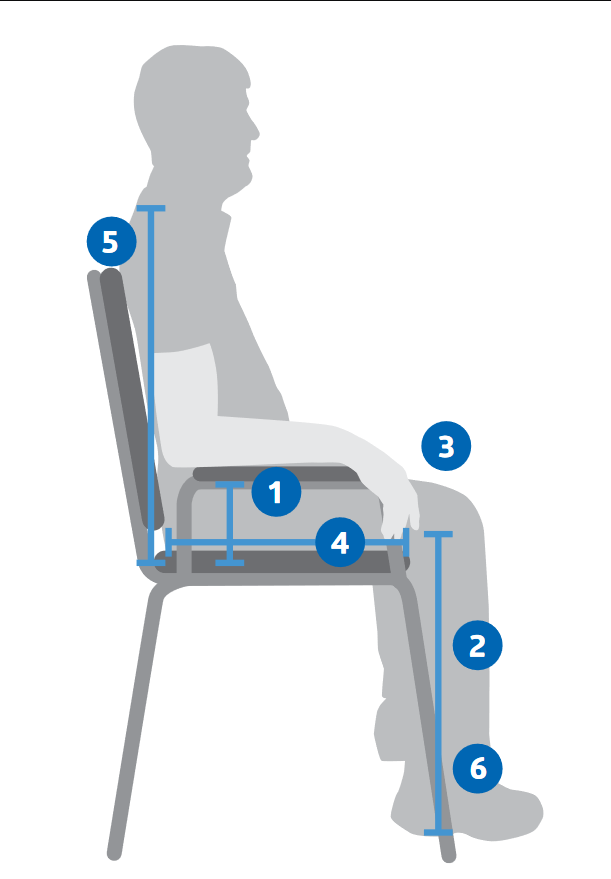
JOIN OUR LIST to get news and alerts of promotions and more!

 We offer a variety of shipping options. Read more...
We offer a variety of shipping options. Read more... Expert assistance and great customer service.
Expert assistance and great customer service.FREE Shipping on all orders $49 or more!
Determine the best fit for your wheelchair in six easy steps.
The most important step to consider when choosing a wheelchair is a proper fit. It can make the difference between recovering well and causing an injury.
Improper fit can cause:

1. Determine Arm Type and Height
Full-length arm: Gives support to pivot transfers when the patient pushes off to stand.
Desk-length arm: Makes it easy to move around tables and desks.
Height: Measure from the elbow to the seat of the chair while holding arms up with elbows bent at a 90-degree angle. Use adjustable arms when possible.
2. Determine Footrest Style
Elevated leg rest: Raises legs
Articulation leg rest: Extends longer for taller patients.
Length: Measure from back of the knee to the heel of the foot.
3. Determine Wheelchair Weight and Weight Limit
Weight capacity: Choose wheelchair weight based on the patient’s weight.
Upper body strength: Choose lighter wheelchairs for weaker patients.
4. Determine Seat Size
Seat width: Measure from hip to hip in a straight line and then add two inches.
Seat depth: Measure from the back of the hip to the back of the knee while seated and then subtract one inch.
5. Determine Back Height
Standard back height: Measure from collarbone to the seat while seated.
Taller back height: Require additional upper trunk support to be installed.
6. Determine Floor to Seat Height
Movement: Check if the patient uses feet to propel or move.
Height: Measure the distance between the back of the knee and the heel.
Comfortable and durable ride with desk length arms and swing away leg rests that make transfers easy with breathable nylon upholstery, smooth-rolling, solid flat-free tires and dual axle hemi-height adjustable for a comfortable user experience. Durable frame in hammertone finish with premium welds stand up to rigorous use. Foot powered movement increases mobility with 2” seat-height adjustments (hemi-height). The basic wheelchair supports up to 300 lbs weight capacity.
Durable hammertone frame; available in nylon or vinyl upholstery
Hemi-height adjustable
Accommodates 2" seat extender
Wheelchairs
When choosing a wheelchair, there are many factors to consider including Arm Style, Leg Style, Weight Capacity and Seat Dimension. We've issued the charts in a way that makes it easier to select the right one.
Arm Style: Many users require the armrests in order to safely perform transfers in and out of a wheelchair. Individuals who can stand also use the armrests for support when getting in and out of the wheelchair. Properly fitted armrests when used help inmaintaining a correct and functional seated posture.
Arm Style choices include:
Leg Style: The main purpose of these leg rests is to redistribute the pressure on the user and increase comfort. There are two options for leg style:
Weight Capacity: Wheelchairs come with varying weight limits. Basic wheelchairs have weight limits of 250–350 lbs, lightweight or pediatric wheelchairs have weight limits of 200–250 lbs, and extra wide and bariatric wheelchairs have weight limits of 500–850 lbs.
Seat Dimensions: Seat widths typically range from 16 to 20 inches, with an average width of about 18 inches. Take seat depth into consideration as it will make a difference in overall comfort and usage. Seat depth is the distance from the back of the seat to the front edge and should be measured when the user is sitting straight up.


| Availability | in stock |
|---|---|
| Manufacturer | Medline |
| Brand | Medline |
| Quantity | No |
| Included in Box | N/A |
| Arm Style | Removable |
| Arm Type | Desk Length
Full Length |
| Arm Height From Floor | N/A |
| Arm Height From Seat | N/A |
| Back Height | 16 " 17" |
| Back Width | N/A |
| Brake Type | N/A |
| Folding Type | N/A |
| Footrest or Legrest Type | Swing Away Elevating |
| Handle Type | N/A |
| HCPCS | N/A |
| Height | 36.5 " 36" |
| Length | N/A |
| Length with Riggings | N/A |
| Material | N/A |
| Materials | Nylon steel |
| Product Assembly | N/A |
| Recline % | N/A |
| Cushion Depth | N/A |
| Cushion Height | N/A |
| Cushion Width | N/A |
| Chair Weight | N/A |
| Chair Size | N/A |
| Seat Depth | 16 " 18" |
| Seat Dimensions | N/A |
| Seat Height | 19" 18.5 |
| Seat Width | 16" 18" 20" |
| Securing Method | N/A |
| Tire Type | N/A |
| Type | Dual Axle |
| Upholstery | N/A |
| Warranty | Yes |
| Weight | 38.000000 |
| Product Weight | N/A |
| Weight Capacity | 300lb |
| Wheels | Rear Wheel Size: 24 " |
| Overall Chair Width | N/A |
| Width | 26.5 " 16" 26" 26.5" 28.5" |